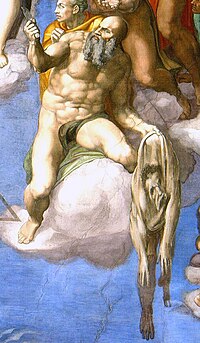The Last Judgment (Michelangelo): Difference between revisions
No edit summary |
NPOV, rmv uncited statement |
||
| Line 1: | Line 1: | ||
[[Image:Last judgement.jpg|right|thumbnail|200px|[[St Bartholomew]] displaying his flayed skin (a self-portrait by Michelangelo) in ''The Last Judgement''.]] |
[[Image:Last judgement.jpg|right|thumbnail|200px|[[St Bartholomew]] displaying his flayed skin (a self-portrait by Michelangelo) in ''The Last Judgement''.]] |
||
The '''''Last Judgment''''' is a painting by [[Michelangelo]] located in the [[Sistine Chapel]] ([[Vatican City]]), above the [[altar]]. |
The '''''Last Judgment''''' is a painting by [[Michelangelo]] located in the [[Sistine Chapel]] ([[Vatican City]]), above the [[altar]]. Taking six years to complete ([[Michelangelo]] began working on it three decades after finishing the ceiling of the [[Chapel]]). |
||
The work is massive and spans the entire wall behind the altar of the Sistine Chapel. It was executed from 1535 to 1541. The Last Judgment is a depiction of the second coming of Christ and the [[Book of Revelation|apocalypse]]. The souls of humans rise and descend to their fates, as judged by Christ and his Saintly entourage. |
The work is massive and spans the entire wall behind the altar of the Sistine Chapel. It was executed from 1535 to 1541. The Last Judgment is a depiction of the second coming of Christ and the [[Book of Revelation|apocalypse]]. The souls of humans rise and descend to their fates, as judged by Christ and his Saintly entourage. |
||
Revision as of 01:13, 3 September 2006

The Last Judgment is a painting by Michelangelo located in the Sistine Chapel (Vatican City), above the altar. Taking six years to complete (Michelangelo began working on it three decades after finishing the ceiling of the Chapel).
The work is massive and spans the entire wall behind the altar of the Sistine Chapel. It was executed from 1535 to 1541. The Last Judgment is a depiction of the second coming of Christ and the apocalypse. The souls of humans rise and descend to their fates, as judged by Christ and his Saintly entourage.
The Last Judgment was an object of a heavy dispute between Cardinal Carafa and Michelangelo: the artist was accused of immorality and intolerable obscenity, having depicted naked figures, with genitals in evidence, inside the most important church of Christianity, so a censorship campaign (known as the "Fig-Leaf Campaign") was organized by Carafa and Monsignor Sernini (Mantua's ambassador) to remove the frescoes. When the Pope's own Master of Ceremonies, Biagio da Cesena, said "it was mostly disgraceful that in so sacred a place there should have been depicted all those nude figures, exposing themselves so shamefully, and that it was no work for a papal chapel but rather for the public baths and taverns," Michelangelo worked da Cesena's semblance into the scene as Minos, judge of the underworld. It is said that when he complained to the Pope, the pontiff responded that his jurisdiction did not extend to hell, so the portrait would have to remain.
The genitalia in the fresco were later covered by the artist Daniele da Volterra, whom history remembers by the derogatory nickname "Il Braghettone" ("the breeches-painter").
The face to the bottom right of the picture is that of Michelangelo himself.
